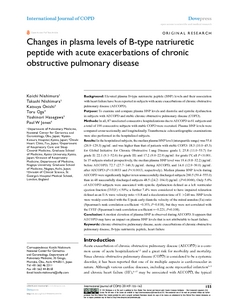Nishimura, K; Nishimura, T; Onishi, K; Oga, T; Hasegawa, Y; Jones, PW
(2014)
Changes in plasma levels of B-type natriuretic peptide with acute exacerbations of chronic obstructive pulmonary disease.
International Journal of Chronic Obstructive Pulmonary Disease, 9.
155 - 162.
ISSN 1176-9106
https://doi.org/10.2147/COPD.S55143
SGUL Authors: Jones, Paul Wyatt
![[img]](https://openaccess.sgul.ac.uk/104910/1.hassmallThumbnailVersion/copd-9-155.pdf)  Preview |
|
["document_typename_application/pdf; charset=binary" not defined]
Published Version
Download (358kB)
| Preview
|
Abstract
Background:
Elevated plasma B-type natriuretic peptide (BNP) levels and their association with heart failure have been reported in subjects with acute exacerbations of chronic obstructive
pulmonary disease (AECOPD).
Purpose:
To examine and compare plasma BNP levels and diastolic and systolic dysfunction in subjects with AECOPD and s
table chronic obstructive pulmonary disease (COPD).
Methods:
In all,87 unselected consecutive hospitalizations due to AECOPD in 61 subjects and a total of 190 consecutive subjects with stable COPD were recruited. Plasma BNP levels were compared cross-sectionally and longitudinally. Transthoracic echocardiographic examinations
were also performed in the hospitalized subjects.
Results:
In the hospitalized subjects, the median plasma BNP level (interquartile range) was 55.4 (26.9–129.3) pg/mL and was higher than that of patients with stable COPD: 18.3 (10.0–45.3)for Global Initiative for Chronic Obstructive Lung Disease grade I; 25.8 (11.0–53.7) for grade II; 22.1 (9.1–52.6) for grade III; and 17.2 (9.6–22.9) pg/mL for grade IV, all P,0.001.
In 15 subjects studied prospectively, the median plasma BNP level was 19.4 (9.8–32.2) pg/mL before AECOPD, 72.7 (27.7–146.3) pg/mL during AECOPD, and 14.6 (12.9–39.0) pg/mL
after AECOPD (P,0.0033 and P,0.0013, respectively). Median plasma BNP levels during AECOPD were significantly higher in ten unsuccessfully discharged subjects 260.5 (59.4–555.0)
than in 48 successfully discharged subjects 48.5(24.2–104.0) pg/mL (P=0.0066). Only 5.6%
of AECOPD subjects were associated with systolic dysfunction defined as a left ventricular ejection fraction (LVEF),50%; a further 7.4% were considered to have impaired relaxation defined as an E/A wave velocity ratio,0.8 and a deceleration time of E.240 ms. BNP levels were weakly correlated with the E/peak early diastolic velocity of the mitral annulus (Ea) ratio (Spearman’s rank correlation coefficient =0.353,P =0.018), but they were not correlated with the LVEF (Spearman’s rank correlation coefficient =−0.221,P = 0.108).
Conclusion:
A modest elevation of plasma BNP is observed during AECOPD. It appears that AECOPD may have an impact on plasma BNP levels that is not attributable to heart failure.
Statistics
Item downloaded times since 26 Sep 2014.
Actions (login required)
 |
Edit Item |




